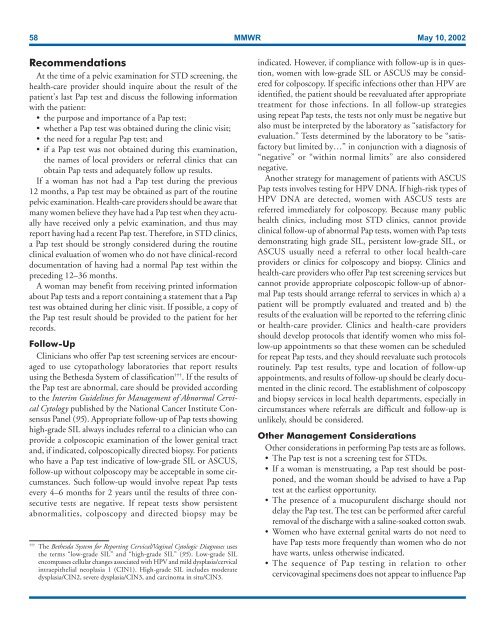You also want an ePaper? Increase the reach of your titles
YUMPU automatically turns print PDFs into web optimized ePapers that Google loves.
58 MMWR May 10, 2002<br />
Recommendations<br />
At the time of a pelvic examination for STD screening, the<br />
health-care provider should inquire about the result of the<br />
patient’s last Pap test and discuss the following information<br />
with the patient:<br />
the purpose and importance of a Pap test;<br />
whether a Pap test was obtained during the clinic visit;<br />
the need for a regular Pap test; and<br />
if a Pap test was not obtained during this examination,<br />
the names of local providers or referral clinics that can<br />
obtain Pap tests and adequately follow up results.<br />
If a woman has not had a Pap test during the previous<br />
12 months, a Pap test may be obtained as part of the routine<br />
pelvic examination. Health-care providers should be aware that<br />
many women believe they have had a Pap test when they actually<br />
have received o<strong>nl</strong>y a pelvic examination, and thus may<br />
report having had a recent Pap test. Therefore, in STD clinics,<br />
a Pap test should be strongly considered during the routine<br />
clinical evaluation of women who do not have clinical-record<br />
documentation of having had a normal Pap test within the<br />
preceding 12–36 months.<br />
A woman may benefit from receiving printed information<br />
about Pap tests and a report containing a statement that a Pap<br />
test was obtained during her clinic visit. If possible, a copy of<br />
the Pap test result should be provided to the patient for her<br />
records.<br />
Follow-Up<br />
Clinicians who offer Pap test screening services are encouraged<br />
to use cytopathology laboratories that report results<br />
using the Bethesda System of classification ††† . If the results of<br />
the Pap test are abnormal, care should be provided according<br />
to the Interim Guidelines for Management of Abnormal Cervical<br />
Cytology published by the National Cancer Institute Consensus<br />
Panel (95). Appropriate follow-up of Pap tests showing<br />
high-grade SIL always includes referral to a clinician who can<br />
provide a colposcopic examination of the lower genital tract<br />
and, if indicated, colposcopically directed biopsy. For patients<br />
who have a Pap test indicative of low-grade SIL or ASCUS,<br />
follow-up without colposcopy may be acceptable in some circumstances.<br />
Such follow-up would involve repeat Pap tests<br />
every 4–6 months for 2 years until the results of three consecutive<br />
tests are negative. If repeat tests show persistent<br />
abnormalities, colposcopy and directed biopsy may be<br />
††† The Bethesda System for Reporting Cervical/Vaginal Cytologic Diagnoses uses<br />
the terms “low-grade SIL” and “high-grade SIL” (95). Low-grade SIL<br />
encompasses cellular changes associated with HPV and mild dysplasia/cervical<br />
intraepithelial neoplasia 1 (CIN1). High-grade SIL includes moderate<br />
dysplasia/CIN2, severe dysplasia/CIN3, and carcinoma in situ/CIN3.<br />
indicated. However, if compliance with follow-up is in question,<br />
women with low-grade SIL or ASCUS may be considered<br />
for colposcopy. If specific infections other than HPV are<br />
identified, the patient should be reevaluated after appropriate<br />
treatment for those infections. In all follow-up strategies<br />
using repeat Pap tests, the tests not o<strong>nl</strong>y must be negative but<br />
also must be interpreted by the laboratory as “satisfactory for<br />
evaluation.” Tests determined by the laboratory to be “satisfactory<br />
but limited by…” in conjunction with a diagnosis of<br />
“negative” or “within normal limits” are also considered<br />
negative.<br />
Another strategy for management of patients with ASCUS<br />
Pap tests involves testing for HPV DNA. If high-risk types of<br />
HPV DNA are detected, women with ASCUS tests are<br />
referred immediately for colposcopy. Because many public<br />
health clinics, including most STD clinics, cannot provide<br />
clinical follow-up of abnormal Pap tests, women with Pap tests<br />
demonstrating high grade SIL, persistent low-grade SIL, or<br />
ASCUS usually need a referral to other local health-care<br />
providers or clinics for colposcopy and biopsy. Clinics and<br />
health-care providers who offer Pap test screening services but<br />
cannot provide appropriate colposcopic follow-up of abnormal<br />
Pap tests should arrange referral to services in which a) a<br />
patient will be promptly evaluated and treated and b) the<br />
results of the evaluation will be reported to the referring clinic<br />
or health-care provider. Clinics and health-care providers<br />
should develop protocols that identify women who miss follow-up<br />
appointments so that these women can be scheduled<br />
for repeat Pap tests, and they should reevaluate such protocols<br />
routinely. Pap test results, type and location of follow-up<br />
appointments, and results of follow-up should be clearly documented<br />
in the clinic record. The establishment of colposcopy<br />
and biopsy services in local health departments, especially in<br />
circumstances where referrals are difficult and follow-up is<br />
u<strong>nl</strong>ikely, should be considered.<br />
Other Management Considerations<br />
Other considerations in performing Pap tests are as follows.<br />
The Pap test is not a screening test for STDs.<br />
If a woman is menstruating, a Pap test should be postponed,<br />
and the woman should be advised to have a Pap<br />
test at the earliest opportunity.<br />
The presence of a mucopurulent discharge should not<br />
delay the Pap test. The test can be performed after careful<br />
removal of the discharge with a saline-soaked cotton swab.<br />
Women who have external genital warts do not need to<br />
have Pap tests more frequently than women who do not<br />
have warts, u<strong>nl</strong>ess otherwise indicated.<br />
The sequence of Pap testing in relation to other<br />
cervicovaginal specimens does not appear to influence Pap


